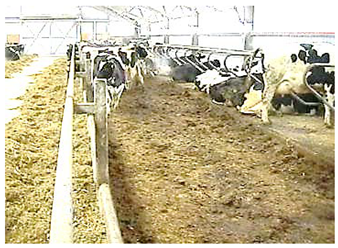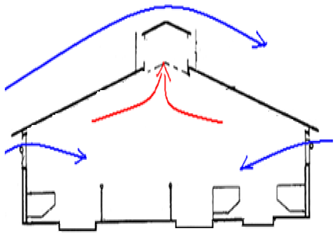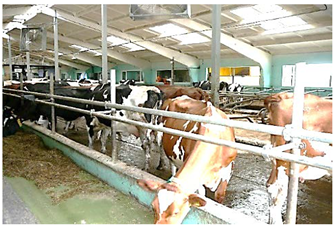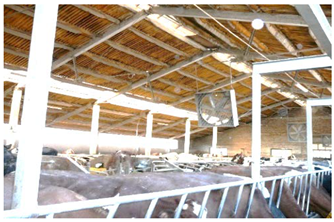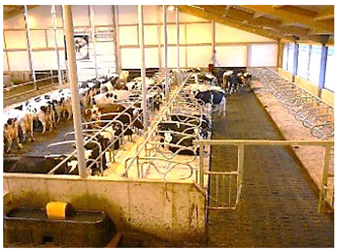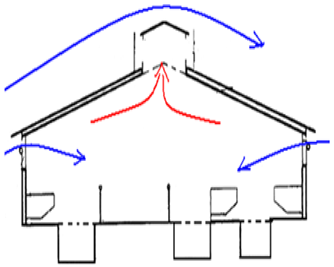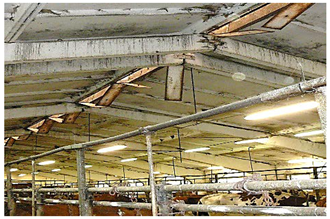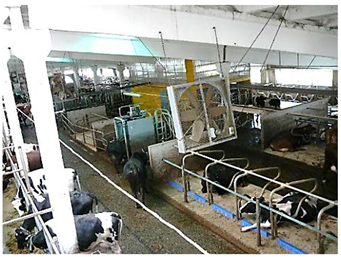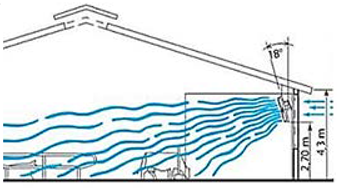Abstract
Heat stress is becoming an increasingly important problem in Lithuanian cowsheds. Microclimate formation systems were evaluated in the seven most popular cowsheds in Lithuania, with different wall and roof constructions, insulation, ventilation intensity controls, and one cowshed was additionally equipped with an air-cooling system—the air is cooled by spraying water droplets with a high pressure. In cowsheds equipped with fans to intensify the movement of air, the temperature does not fall below the outdoor temperature and the temperature humidity index (THI) is higher than outdoors. During the heat period, the THI rises to 82 and the cows get moderate thermal stress, which adversely affects feed intake and milk yield of dairy cows. In the cowshed, where the air humidification–cooling system is installed, the air temperature during heat is lower than the average in the field of 2.61 ± 0.74 °C. Although the relative humidity in the cowshed is on average 16.29 ± 4.12% wetter during heat than outside, the THI in the barn is lower than outside. The air temperature in this cowshed decreases by 3.17 ± 0.86 °C compared to cowsheds without an air humidification–cooling system. The air humidification–cooling system creates good conditions to reduce the conditions for cows to experience thermal stress. Further research is needed to optimize the amount of water spray and droplet size and increase the efficiency of the cooling system.
1. Introduction
Farms are growing, robots are carrying more and more work in barns, cattle housing technological processes are being automated, digital systems for process control and management are being installed in barns, cow productivity is increasing, and the climate is changing. These are factors that need to be considered when choosing a barn design and ventilation system. The purpose of the barn is to create good conditions for the animals. The barn must be properly constructed and have an efficient ventilation system. In summer, it is necessary to control and limit the access of direct sunlight to the barn. The barn must protect the cows from the cold winter wind, rain, and snow, and provide shade from the hot summer sun. In modern farms, cows are kept in barns all year round. As the climate changes, there are more and more problems with creating a good microclimate in the cowsheds in the summer, and how to avoid heat stress for the cows. Optimizing ventilation intensity is essential to reduce emissions and ensure a good microclimate in cowsheds [1,2,3]. The ventilation system must maintain a good microclimate in the barn by removing excess moisture and gas and control the condensation of water vapor. This is very important because the health and productivity of cattle are highly dependent on the microclimate of the barn. As the ambient temperature and relative humidity rise, the animal’s heat output is reduced, the body’s thermoregulatory mechanism is disrupted, and there is a risk of overheating. Protecting animals from overheating requires reducing the relative humidity by increasing the speed of air movement through natural or artificial ventilation [4,5]. Measures are needed to reduce the temperature in the cowsheds and the effects of heat on the cows. The heat of summer has a negative effect on the productivity and feed consumption of dairy cows. Therefore, management strategies are needed to reduce heat exposure and achieve optimal productivity in dairy cows [6].
Much research has been conducted to analyze microclimate factors in naturally ventilated barns and to find ways to improve the microclimate in cowsheds and reduce air pollution [7,8,9,10,11,12]. Researchers acknowledge that there are many problems in analyzing and controlling the microclimate in open, naturally ventilated barns. The intensity of ventilation and the concentration of gas in them depend mainly on the wind speed and the difference in air temperature between the barn and the field [13]. One of the most important factors in the microclimate is temperature, which also affects other factors. The air temperature in the barn is a qualitative indicator of ventilation efficiency, from which other factors can be assessed. The air speed in the barn is also an important qualitative indicator of ventilation efficiency. Although air temperature is the best indicator of ventilation, air humidity must also be investigated [12]. Control should be based on humidity and air quality, not comfortable temperatures [6].
Animals kept in cold, humid, and poorly ventilated areas eat more feed, lose weight, lose milk, and are more prone to respiratory, udder, and other diseases [14]. In order to create a good microclimate and reduce feed intake, some researchers suggest building insulated cowsheds [15]. However, such cowsheds are often damp. With high humidity in the barn, environmental conditions will be equally detrimental at both low and high temperatures. It will also create good conditions for the active activity of bacteria, which will increase the emission of ammonia from manure. A common problem in cowsheds is the high relative humidity and sometimes high concentrations of ammonia. The relative humidity of the air is high at different times of the year. Cowshed air quality is worse during the cold season [16,17,18,19]. This is due to the reduced ventilation intensity being too low to avoid low temperatures.
When modernizing barns there are often problems with the microclimate, such as the intensive ventilation of the barn, the right temperature in the barn, clean air, what kind of roof structure to use, and how to insulate it [20]. It is necessary to identify the most suitable barn for cows in each region in order to reduce the challenges of climate change. In warm regions, a thatched roof is most suitable, and a cement-roofed is most unsuitable in this region [21].
Heat stress can adversely affect a cow’s physiology, behavior, and milk production. The temperature humidity index (THI) is used as a measure of thermal comfort. By using a fog system in the cowshed, air temperature and THI can be reduced [19,20]. When the THI rises above 72, cows get heat stress. Feed consumption and cow productivity then decline. Measures are needed to reduce the temperature in the cowsheds and the effects of heat on the cows. Three levels of thermal stress can be distinguished depending on the THI value: mild stress 72–79; moderate stress 79–89; and strong stress > 89 [6].
The health and productivity of cattle are highly dependent on the microclimate of the barns. As the ambient air temperature and relative humidity rise, the heat released by convection decreases, thus unbalancing the body’s thermoregulatory mechanism—and overheating occurs [5]. When the temperature rises above 28–30 °C, feed consumption and cow productivity decrease [14]. Temperatures above 23 °C have a negative effect on cow productivity. When the temperature rises above 35 °C, the productivity of cows decreases by up to 50% [15]. Ammonia emission is greatly intensified at high temperatures [20]. Therefore, it is very important to reduce the air temperature in the cowsheds during heat, or take other measures to reduce ammonia emissions, e.g., probiotics [21].
In Lithuania, the warm period lasts for three months. Air temperatures above 20 °C occur at 1150–1280 h per year. Therefore, the heat in the summer is becoming an increasingly important problem for cattle farmers. Measures are needed to reduce the temperature in the cowsheds and the effects of heat on the cows.
According to predictable climate change, in the context of global warming, it is vital to take preventive measures against the negative effects of solar radiation on the welfare of cattle. In addition to water sprinklers and ventilators in barns, various shade-forming systems are increasingly used in barns, trees, curtains, etc. [22]. There is a lack of data on the impact of irrigation systems on the microclimate of cowsheds for the efficient use of cooling systems.
The aim of the research is to identify the main problems of microclimate formation in cowsheds and to evaluate the possibilities of expanding the thermal comfort zone for a cow during the heat period using an air humidification system.
2. Materials and Methods
Experimental microclimate studies were performed in cattle barns of various constructions. The most popular cowsheds in Lithuania have been selected (Table 1, Figure 1).

Table 1.
Experimental microclimate research performed in the most popular cowsheds in Lithuania.

Figure 1.
Technological structure of most popular cowsheds in Lithuania.
In the selected cowsheds, the cows are kept in the barn all year round. All cowsheds are boxed, with different barn wall and roof constructions, their insulation, manure removal systems, and microclimate formation systems. The cowsheds are equipped with slit ventilation systems, cowsheds 1 and 5 do not have fans to intensify the movement of air, other cowsheds are equipped with fans, and cowshed 7 is additionally equipped with air humidification—an air-cooling system.
The following microclimate factors were studied in cowsheds at different times of the year: air temperature, relative humidity, and air velocity. Air temperature and relative humidity recorded hourly with temperature–humidity programmable stand-alone meters MicroLite LITE5032P-RH Fourtec. Temperature range −40 to 80 °C, temperature accuracy 0.3 °C, temperature resolution 0.02 °C, humidity range 5 to 95%, humidity accuracy 2% RH, humidity resolution 0.05% RH (Made in Germany). Air velocity was measured with a wing anemometer in the Almemo 2590-9 system (Ahlborn GmbH, Hildesheim, Germany). Measurement range 0–10 m s−1, accuracy ±0.1 m s−1.
During the research, microclimate factors were recorded in 5–7 places in cowsheds and 2 places in the field. The efficiency of ventilation systems was evaluated by analyzing air temperature and relative humidity in the barns. Thermal comfort is measured by the temperature and humidity index (THI), which is calculated by the equation [22]:
here:
Ta—air temperature, °C,
RH—relative humidity of the air, %.
The obtained data were analyzed by the polynomial correlation and regression method. The standard error and the minimum confidence interval were calculated at the level of statistical significance p < 0.05.
3. Results
The ventilation system must create a good microclimate in the cowshed at all times of the year: hot and cold. It is very important to create a thermostable state in the animal’s body, ensuring a balance of energy heat exchange between it and the environment. Excess heat produced in animals is released into the environment by convection, radiation, and conduction. By controlling these heat exchange processes, an optimal balance of heat exchange between the animal and the environment can be achieved. When the amount of heat in the animal’s body is stable, thermal comfort is created for the animals. The zone of thermal comfort (minimum and maximum critical ambient temperature) is very important for the animal’s body, where the thermoregulation of the cow’s body takes place best and its maximum productivity is obtained. Therefore, it is very important to install efficient ventilation systems in cowsheds. The ventilation system must remove excess heat and moisture, harmful gases, and control condensation.
3.1. Microclimate (Air Temperatures and Relative Humidity Dynamics) Formation Systems in Insulated Tied Cowshed
Microclimate formation systems have been evaluated in the seven most popular cowsheds in Lithuania, where wall and roof constructions, insulation, and ventilation intensity control differ, one cowshed is additionally equipped with an air-cooling system—air is cooled by high pressure spraying water droplets. The main problem in cowsheds is high humidity during the cold season and high temperatures during the heat. The wettest air is in insulated barns. In these cowsheds, the temperature usually meets the requirements.
However, when the outdoor temperature drops, a positive temperature in the barn is achieved by reducing the intensity of ventilation and deteriorating the cleanliness of the air. Due to insufficient ventilation intensity, the relative humidity of the air is close to 100%, and even with a small drop in temperature, water vapor condensate forms on building structures. Although low temperatures are less harmful to cows than a high humidity, a bad solution is often chosen to maintain a higher temperature in the barn by increasing the humidity in the barn. Only with a sufficiently intensive ventilation of the barn is it possible to create a good microclimate in the cowshed at low outdoor temperatures. It is important not to over-open the ventilation ducts to remove excess moisture from the barn. In an insulated cowshed we can maintain a temperature higher than 0 °C and the humidity will not exceed 90% (Figure 2).
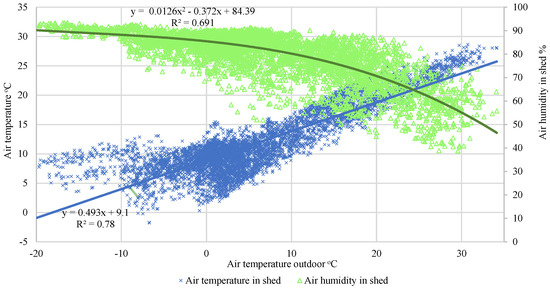
Figure 2.
Air temperatures and relative humidity dynamics in insulated tied cowshed (5 cowshed) related to outdoor temperatures.
3.2. Microclimate (Air Temperatures and Relative Humidity Dynamics) Formation Systems in Uninsulated Cowshed Box-Type
The air is drier in uninsulated-cold barns (Figure 3). In cold barns, the air humidity is not high during the warm season, the humidity only increases when the weather is cold, if too many ventilation ducts are opened. In these barns, the technological equipment can work even at low temperatures, so it is not appropriate to significantly reduce the intensity of ventilation during the cold in order to maintain higher temperatures in the barn.
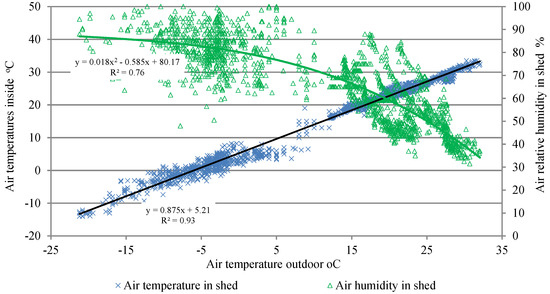
Figure 3.
Air temperatures and relative humidity dynamics in uninsulated cowshed box-type (1 cowshed) related to outdoor temperatures.
During the winter, the temperature in cold barns can drop below −10.0 °C for a decade. In the event of a drop-in temperature, measures must be taken to reduce the heat transfer of the cow so as not to disturb its energy balance. However, the main problem in these cowsheds is not the low temperatures in winter but the high temperatures in summer when the animals can experience severe heat stress.
3.3. Air Temperatures Related to Outdoor Temperatures in Different Cowsheds
In semi-insulated box-type cowsheds (only the roof of the barn is insulated), the microclimate parameters also deteriorate during the cooler part of the year and during the heat. In cowsheds, the air temperature drops below 0 °C when it is colder than −9.7–−8.1 °C outside. In winter, the coldest time in the barn is from 7:00 to 10:00, and in summer the hottest is from 15:00 until 19:00. The relative humidity of the air in semi-warm cowsheds varies in a wide range from 38.4% to 96.5%. Humidity above recommended is usually a few percent. The wettest weather in the cowsheds is in spring and autumn (September) and meets the requirements during the cold period. During the warm season, the humidity in the barn increases at night and in the morning (from 1:00 to 8:00). The main cause of poor microclimate in barns is usually not a poorly equipped ventilation system, but the improper operation of ventilation systems and usually too little ventilation intensity. By properly regulating the intensity of ventilation, a compromise between air temperature and air cleanliness can be found in cowsheds.
The ventilation of a semi-warm cowshed with a sufficiently intense result in a strong relationship between the relative humidity of the air in the barn and outside (R2 = 0.91). In the barn, the humidity increases only for short periods and meets the requirements at almost all times of the year. In a semi-warm cowshed, as well as in a cowshed, it is possible to achieve cold, d damp, and clean air in the barn. The most important thing is that there is no overlap (ceiling) in the barn and no more space for the animal, no accumulation of urine in the barn, and no large open surfaces from which water and various gases evaporate (usually ammonia).
The main problem in cowsheds in Lithuania is not the low temperature or high humidity, but the heat stress experienced by cows during high temperatures. During heat, the temperature is too high in all barns, in uninsulated cowsheds it is 7–10 °C higher than the recommended maximum (25 °C), and in insulated cowsheds it is 5–6 °C higher. In uninsulated cowsheds the temperature rises above 25 °C, when the outdoor temperature is higher than 22.1–23.12 °C, and in cowsheds with insulated roofs—above 24.35–27.87 °C. Different temperatures in the barns are determined by the construction of the barn, the insulation of the building enclosures, the stocking density, and the intensity of ventilation. A detailed comparison of temperatures in cowsheds is given in Figure 4. This figure shows the change of air temperatures in different cowsheds, the temperatures in them were calculated according to the established strong correlation (R2 > 0.90) between the air temperature in the barn and the temperature in the field. During the heat, it is too hot in all cowsheds, even in barns with an insulated roof.

Figure 4.
Air temperatures in cowsheds related to outdoor temperatures.
The air temperature in the semi-warm cowshed rises above 25 °C from 13:00 until 20:00 (Figure 5), an average of 7 h during the day. Such temperatures occur in semi-warm cowsheds (cowshed four; cowshed six) on average throughout July. The maximum temperature is 16:00–17:00, it rises to 27.29 ± 0.16 °C. Analyzing temperatures from 7:00 p.m. until 20:00, we found that the temperature in the cowshed was on average 0.56 ± 0.12 °C higher than outside. The fans installed in the cowsheds do not cool the barn, they only intensify the convective heat exchange between the animal and the ambient air.
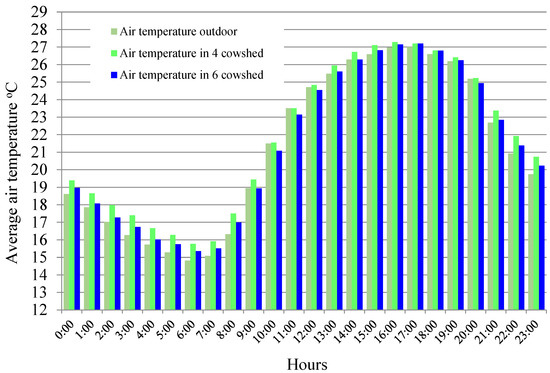
Figure 5.
Average daily air temperature change in the first decade of July (4 cowshed; 6 cowshed).
3.4. Air Humidification–Cooling System Effectiveness in Semi-Insulated Box-Type Cowshed
The situation is better in cowshed seven, which is equipped with an air humidification–cooling system. During heat, the air temperature in the cowshed is lower than in the open air, when humidification is activated at temperatures above 20 °C. It runs from 7:00 p.m. until 20:00. The average data for the first decade of July show that in this cowshed during the heat from 7:00 am. until 20:00 the air is on average 2.61 ± 0.74 °C cooler than outdoors (Figure 6). However, the air in the cowshed is wetter. The relative humidity of the air in the cowshed during heat is on average 16.29 ± 4.12% wetter than in the open air.
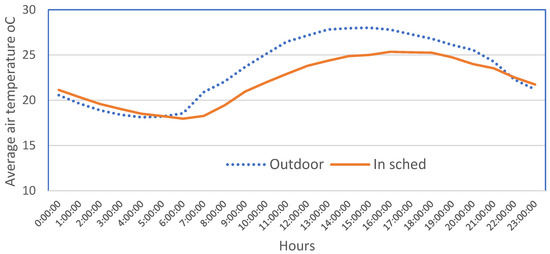
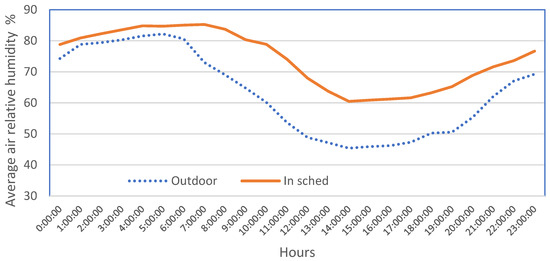
Figure 6.
Average daily air temperature and relative humidity change in the first decade of July (7 cowshed).
The outdoor temperature and humidity index are higher than in this cowshed, so the cooling intensity is efficient. The air temperature drops to 3.17 ± 0.86 °C compared to cowsheds without an air humidification–cooling system. The THI from 12 p.m. until 8 p.m. rises above 72 (Figure 7) and peaks at 16:00. (73.5 ± 0.6).
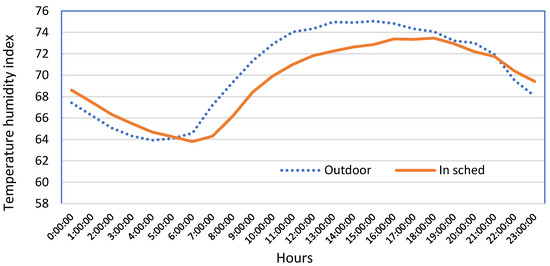
Figure 7.
Average daily air temperature and humidity index change in the first decade of July (7 cowshed).
When the weather cools down in September–November and no humidification–cooling is used, the temperature–humidity index in the barn is higher than in the field (Figure 8).
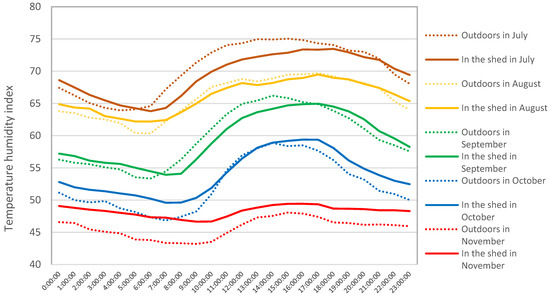
Figure 8.
Average daily air temperature and humidity index change in the first decade of different months (7 cowshed).
In July, the THI in the field was higher than in the barn, equal to 70.6 ± 6.4 and 69.5 ± 5.9, respectively. In August, when the irrigation system is used less, the difference between the temperature and humidity index in the barn and in the field decreases: in the field it is 65.8 ± 3.5, and in the barn 66.0 ± 5.4. In November, when the irrigation system is not used, the THI is significantly higher in the barn: 48.3 ± 2.4 in the barn and only 45.6 ± 1.8 in the field (Figure 9). This shows efficient air cooling using an air humidification system.
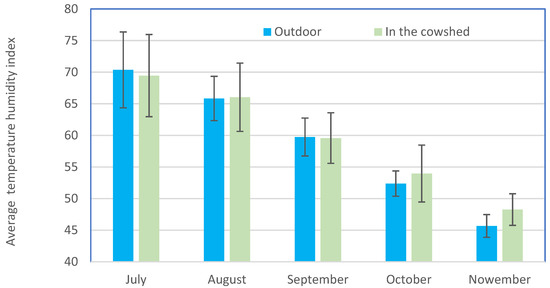
Figure 9.
Average air temperature and humidity index in the different months (7 cowshed).
In cowsheds equipped with only fans to intensify air movement, the temperature does not drop, and the THI is higher than in a cowshed with an air humidification–cooling system (Figure 10). Therefore, ventilation control strategies are needed to reduce the exposure of cows to heat and to achieve optimal productivity in dairy cows. Cowsheds can be cooled with air flow and spray water. Such barn cooling is a good protection against high temperature stress.
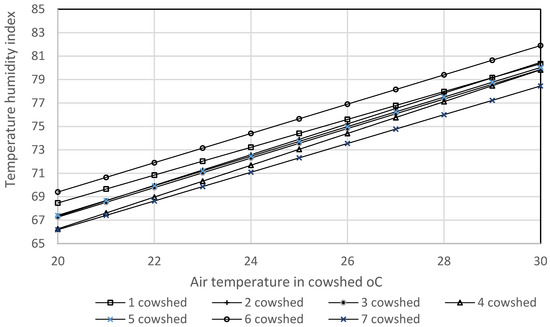
Figure 10.
Variation of temperature and humidity index in different cowsheds during the heat period.
It is important to ventilate each cowshed correctly. The highest ventilation intensity in the barn is required to remove excess water vapor. Therefore, it is sufficient to regulate the ventilation intensity of cattle barns according to the amount of water vapor. The poor microclimate in cowsheds is usually due to high temperatures. In all cowsheds, bitters are too hot, the temperature rises above 25 °C, and mild heat stress can occur in cows (Table 2). The temperature rises most intensively in an uninsulated cowshed, and the lowest rises in a cowshed equipped with an air humidification–cooling system. When analyzing the change in temperature and humidity, the best results are also found in the cowshed with irrigation. It has the lowest THI index and the best opportunities for cows to avoid heat stress. The relatively low air velocities in the cowsheds indicate good opportunities to increase the intensity of ventilation and improve the conditions for the cows to release heat to the environment.

Table 2.
Outdoor climate conditions that cause unfavorable microclimates in cowsheds (p < 0.05).
In Lithuania, cold (uninsulated) or semi-warm barns are built for cows. The cold cowsheds have an outdoor temperature, and the barn only protects the animals from wind, rain, and snow and sunlight in hot weather. These barns have a higher roof pitch and higher walls. This allows warm and humid air to flow into the open ridge. Ventilation through the open side walls is intensified by the wind. In these barns, the heated roofing is further away from the area where the animals are present, and this helps to protect the animals from high heat stress. However, these barns have a high temperature, rising above 25.0 °C when it is only 22.6 °C outside. In uninsulated cowsheds, light heat stress occurs when the outdoor temperature rises above 23.0 °C. In cowsheds with an insulated roof, mild heat stress occurs when the outdoor temperature rises to 22.2–24.9 °C.
All cow identification code sensors in the barn monitor cow productivity and shepherd quality factors. It was assessed whether the general microclimate parameters correspond to the optimal ones, which give the cows a well-being and a suitable environment. Therefore, the veterinary indicators of the cows themselves were not collected as additional information. It is considered that the individual veterinary performance of the cows was maintained, and no adverse effects were observed in maintaining an appropriate microclimatic environment in the barn, but no detailed additional assessments were performed. A more detailed analysis and monitoring of cow indicators can be expected in the future.
The air humidification system in the cowshed is switched on when the air temperature in the barn rises to 22.0 °C. In Lithuanian cowsheds, such a hot period lasts up to 452–495 h per year, and it is advisable to use an air humidification–cooling system in the barns. During this period, a total of 347, 136–380, and 160 L of water will be used in the 244-seat cowshed (seven cowsheds), which is equipped with 16 fans with water jets.
The power of the fan, which spreads water droplets under the barn, is 0.80 kW. A total of 0.8 kWh of energy will be consumed in one hour of operation. After estimating the water supply costs (EUR 0.41 m−3), we get that the water supply will cost EUR 142–156 (according to the data of the Lithuanian State Energy Regulatory Council in the regions of Lithuania). According to the data of the Lithuanian State Energy Regulatory Council in the regions of Lithuania. It was used average basic price of drinking water supply services 1 m3, EURr/m3 without VAT. These increased costs are offset by a decrease in cow productivity during heat, with cows producing an average of 29.5 L of milk per day during heat. Without barn air cooling, the productivity of cows would have decreased by up to 6%, which corresponds to 432 L of milk per day from all cows or about 20,740 L during the whole hot period. The information on milk purchase prices was taken in accordance with the rules for collecting data from buyers of raw milk on 1 November 2021, approved by the Minister of Agriculture of the Republic of Lithuania in 2015. July 27 by order no. 3D-603 “On Approval of the Rules for Collecting Data from Raw Milk Buyers”, information on raw milk purchase prices is collected and published by the State Enterprise Agricultural Information and Rural Business Center. The cooling of the barn helps to maintain the productivity of cows and increase the income of EUR 9330 for the milk sold (the purchase price of milk is 0.45 EUR l−1).
4. Discussion
Air temperature is a suitable indicator of ventilation [8]. It was found that a water-cooled system can reduce the temperature and humidity index [23]. The cooling system reduces the effects of heat stress, but the animals still experience mild stress. When the THI rises above 72, cows experience heat stress. Feed consumption and cow productivity then decline. In cowsheds, the THI rises to 82 during the heat and the cows experience moderate thermal stress, which adversely affects the milk yield and feed intake of dairy cows [6]. The researchers evaluated the effectiveness of roof-mounted misted fans to improve the heat and humidity index in different cooling zones and levels compared to darker and open zones. The mean THIout value was 87.49, and the mean value of the adjusted outdoor temperature and humidity index THIadj was 10% higher than the THIout after estimating solar radiation. The largest difference between the hourly averages of the CPI and the CPI occurred at noon, when the intensity of solar radiation was highest. The average value under the fog fans THIfan was 82.27 and inside the cowshed under the shadow THIshade was 85.20. Fog fans have been able to reduce the thermal stress to a limited extent, but further improvements in the design aspects of the cowshed and an increase in cooling efficiency are needed [24].
Furthermore, modeling of the operation of the barn recuperative ventilation system with air flow adsorption equipment in livestock farms showed that the required microclimate in the barn is ensured [25]. The control group received cooling sessions according to a pre-determined schedule, a method commonly used on farms; and an experimental group that received a sensor-based (SB) cooling mode. In both variants, the milk yield of the cows was similar (44.7 kg per day), but the experimental group had a higher milk fat content (3.65 and 3.43%), milk protein content (3.23 and 3.13%), and energy-adjusted milk (ECM) 42.84 vs. 41.48 kg d−1), higher fat milk 4%; (42.76 vs. 41.34 kg d−1), and a shorter duration of heat stress (5.03 vs. 9.46 h per day) compared to the controls. Dry matter intake was higher in the experimental group. A sensor-based cooling regime can be an effective means of detecting and reducing heat stress in high-productivity dairy cows during transition seasons where dry and semi-dry areas may have high heat loads [26]. In the study of the influence of heat stress period and fan cooling on the physiology, milk production, and morbidity of milking cows (at different stages of lactation), the average temperature in the cowshed under heat voltage was almost 30 °C with a relative cooling system, a relative humidity of 82%, a wind speed of 1, 35 m s−1, and the temperature–humidity index (THI) did not exceed the range of moderate heat stress. The cooling system sprayed by the fan could not significantly improve the thermal environment of the cowshed [27].
The concept of passive cooling has been used to improve the beef cattle houses of small farmers, considering the existing constraints on farmers capital and construction capacity. The hull size, roof shape, and roofing materials have been altered to provide adequate heat protection and increased cross and column ventilation. The position of the buildings around the cattle houses was remodeled to allow more drafts into the house. After the renovation, the indoor temperature was observed to be up to 5 °C lower than the outdoor temperature, and the humidity was reduced by 60–72% [28].
As an alternative, the use of a patented direct contact air, gravel, ground heat exchanger (acronym GAHE) at the Wroclaw University of Science and Technology was used to improve the microclimate parameters in dairy barns. An increase in the minimum amount of ventilation air during the winter season and a decrease in the maximum values of this parameter in the summer were observed [29]. The aim of the other study was to describe heat stress reduction strategies and the microclimate in SDF cowsheds from four typical dairy regions of Vietnam (southern lowlands, southern highlands, northern lowlands, and northern highlands) and to determine storage parameters most relevant to the microclimate. On average, from 8:00 to 18:00, the microclimate in cowsheds was considered hot (HLI > 79) in the highlands and very hot (HLI > 86) in the lowlands. The cows accumulated a high heat load in the lowlands (AHLU > 50) by 18:00. The use of roof trowels in combination with AT and HLI fans resulted in a reduction of 1.3 °C and 3.2 units, respectively, at 2:00 PM vs. 11:00 AM. Each increase in 100 m height was associated with a 0.4 °C decrease in AT, a 1.3 unit decrease in HLI, and a 0.8 unit decrease in THI (p < 0.001). Each meter increase in the roof cornice height was associated with a decrease in AT of 0.87 °C, a decrease in HLI of 3.31 units, a CPI of 1.42 units, and an increase in AS of 0.14 m/s (p < 0.05). Cowshed parameters that should be a priority for future studies to reduce thermal stress in SDF cows include the use of roof extenders in conjunction with fans, height increase, cornice roof height, and floor area per cow [30].
5. Conclusions
In cowsheds, the thermal stress experienced by cows during the heat due to the increase in THI has a negative effect on feed consumption and milk yield of dairy cows. Therefore, ventilation management strategies are needed to reduce the exposure of cows to heat and to achieve optimal productivity in dairy cows. Cowsheds can be cooled with air flow and water spray. Such barn cooling is a good protection against high temperature stress. In the cowshed, where the air humidification–cooling system is installed, the air temperature during heat is lower than the average in the field of 2.61 ± 0.74 °C. Although the relative humidity in the cowshed is on average 16.29 ± 4.12% wetter than in the open air, the THI in the barn is lower than in the open air. Therefore, the cooling intensity in the cowshed is efficient, and cows can experience only mild thermal stress when the THI increases by more than 72. In this cowshed the air temperature decreases by 3.17 ± 0.86 °C compared to cowsheds without an air humidification–cooling system.
The air humidification–cooling system creates good conditions to reduce the conditions for cows to experience thermal stress. Further research is needed to optimize the amount of water spray and droplet size and increase the efficiency of the cooling system.
Author Contributions
Conceptualization, R.B. and V.N.; methodology, R.B.; software, V.N.; validation, J.Č.; formal analysis, R.B.; investigation, V.N. and R.B.; writing—original draft preparation, J.Č., R.B. and V.N.; writing—review and editing, V.N.; visualization, R.B. All authors have read and agreed to the published version of the manuscript.
Funding
This research received no external funding.
Institutional Review Board Statement
Not applicable.
Informed Consent Statement
Not applicable.
Data Availability Statement
Not applicable.
Conflicts of Interest
The authors declare no conflict of interest.
References
- Yi, Q.; Zhang, G.; König, M.; Janke, D.; Hempel, S.; Amon, T. Investigation of discharge coefficient for wind-driven naturally ventilated dairy barns. Energy Build. 2018, 165, 132–140. [Google Scholar] [CrossRef]
- Kaasik, A.; Maasikmets, M. Concentrations of airborne particulate matter, ammonia and carbon dioxide in large scale uninsulated loose housing cowsheds in Estonia. Biosyst. Eng. 2013, 114, 223–231. [Google Scholar] [CrossRef]
- Ngwabie, N.M.; Jeppsson, K.H.; Nimmermark, S.; Swensson, C.; Gustafsson, G. Multi-location measurements of greenhouse gases and emission rates of methane and ammonia from a naturally-ventilated barn for dairy cows. Biosyst. Eng. 2009, 103, 68–77. [Google Scholar] [CrossRef]
- Caenegem, L.V.; Wechsler, B. Stallklimawerte und Ihre Berechnung; FAT: Tanikon, Switzerland, 2000; p. 89. [Google Scholar]
- Cirnicchiaro, N.; Rentiz, D.G.; Whitet, B.J.; Babcock, A.H.; Fox, J.T. Associations between weather conditions during the first 45 days after feedlot arrival and daily respiratory disease risks in autumn-placed feeder cattle in the United States. J. Anim. Sci. 2012, 90, 1328–1337. [Google Scholar] [CrossRef] [Green Version]
- Könyves, T.; Zlatković, N.; Memiši, N.; Lukač, D.; Puvača, N.; Stojšin, M.; Halász, A.; Miščević, B. Relationship of temperature-humidity index with milk production and feed intake of holstein-frisian cows in different year seasons. Thai J. Vet. Med. 2017, 47, 15–23. [Google Scholar]
- Frederick, K.T.; Hautala, M.; Pastell, M.; Praks, J.; Eerma, I.; Poikalainen, V.; Pajumagi, A.; Kivinen, T.; Ahokas, J. Microclimate and ventilation in Estonian and Finnish dairy buildings. Energy Build. 2008, 40, 1194–1201. [Google Scholar]
- Pajumagi, A.; Poikalainen, V.; Veerma, I.; Praks, J. Spatial distribution of air temperature as a measure of ventilation efficiency in large uninsulated cowshed. Build. Environ. 2008, 43, 1016–1022. [Google Scholar] [CrossRef]
- Kang, J.H.; Lee, S.J. Improvement of natural ventilation in a large factory building using a louver ventilator. Build. Environ. 2008, 43, 2132–2141. [Google Scholar] [CrossRef]
- Zhao, L.Y.; Bruger, M.F.; Manuron, R.B. Variations of air quality of New Ohio dairy facilities with natural ventilation systems. Aplied Eng. Agric. 2007, 23, 339–346. [Google Scholar] [CrossRef] [Green Version]
- Snell, H.G.J.; Seipelt, F.; van den Weghe, H.F.A. Ventilation Rates and Gaseous Emissions from Naturally Ventilated Dairy Houses. Biosyst. Eng. 2003, 86, 67–73. [Google Scholar] [CrossRef]
- Joo, H.S.; Ndegwa, P.M.; Heber, A.J.; Bogan, B.W.; Ni, J.Q.; Cortus, E.L.; Ramirez-Dorronsoro, J.C. A direct method of measuring gaseous emissions from naturally ventilated dairy barns. Atmos. Environ. 2014, 86, 176–186. [Google Scholar] [CrossRef]
- Vtoryi, V.; Vtoryi, S.; Lantsova, E.; Gordeev, V. Effect of water conditions on content of carbon dioxide in barns. In Proceedings of the 15th International Scientific Conference Engineering for Rural Development, Jelgava, Latvia, 25–27 May 2016; pp. 431–437. [Google Scholar]
- Ajdini, S.; Berberi, P.; Ceroni, V.; Sherifi, K. Hygienical factors of the enviroment and bronchopneumonia in calves. Angl. J. 2015, 4, 293–298. [Google Scholar]
- Brouček, J.; Novák, P.; Vokřálová, J.; Šoch, M.; Kišac, P.; Uhrinčat, M. Effect of high temperature on milk production of cows from free-stall housing with natural ventilation. Slovak J. Anim. Sci. 2009, 42, 167–173. [Google Scholar]
- Krastev, K. Ecological assessment of season dynamics of microclimate in a building for 200 cows. Bulg. J. Anim. Husb. 2015, 5, 37–41. [Google Scholar]
- Huang, D.; Guo, H. Diurnal and seasonal variations of odor and gas emissions from a naturally ventilated free-stall dairy barn on the Canadian Prairies. J. Air Waste Manag. Assoc. 2017, 67, 1092–1105. [Google Scholar] [CrossRef]
- Saha, C.K.; Ammon, C.; Berg, W.; Fiedler, M.; Loebsin, C.; Sanftleben, P.; Brunsch, R.; Amon, T. Seasonal and diel variations of ammonia and methane emissions from a naturally ventilated dairy building and the associated factors influencing emissions. Sci. Total Environ. 2014, 468–469, 53–62. [Google Scholar] [CrossRef]
- Zhang, G.; Strom, J.S.; Li, B.; Rom, H.B.; Morsing, S.; Dahl, P.; Wang, C. Emission of ammonia and other contaminant gases from naturally ventilated dairy cattle buildings. Biosyst. Eng. 2005, 92, 355–364. [Google Scholar] [CrossRef]
- Sivakumar, T.; Suraj, P.T.; Yasotha, A.; Phukon, J. Identification of suitable housing system for dairy cattle in North East Zone of Tamil Nadu, India, with respect to microclimate. Vet. World 2017, 10, 1–5. [Google Scholar] [CrossRef] [Green Version]
- Almuhanna, E.A.; Gamal, R.G.; Omer, E.O.; Faisal, M.A. Performance of roof-mounted misting fans to regulate heat stress in dairy cows. J. Therm. Biol. 2021, 99, 102984. [Google Scholar] [CrossRef]
- Levit, H.; Pinto, S.; Amon, T.; Gershon, E.; Kleinjan-Elazary, A.; Bloch, V.; Ben Meir, Y.A.; Portnik, Y.; Jacoby, S.; Arnin, A.; et al. Dynamic cooling strategy based on individual animal response mitigated heat stress in dairy cows. Animal 2021, 15, 100093. [Google Scholar] [CrossRef]
- Angrecka, S.; Herbut, P.; Nawalany, G.; Sokołowski, P. The impact of localization and barn type on insolation of sidewall stalls during summer. J. Ecol. Eng. 2017, 18, 60–66. [Google Scholar] [CrossRef]
- Bleizgys, R.; Bagdoniene, I. Control of ammonia air pollution through the management of thermal processes in cowsheds. Sci. Total Environ. 2016, 568, 990–997. [Google Scholar] [CrossRef] [PubMed]
- Naujokienė, V.; Bagdonienė, I.; Bleizgys, R.; Rubežius, M. A Biotreatment effect on dynamics of cattle manure composition and reduction of ammonia emissions from agriculture. Agriculture 2021, 11, 303. [Google Scholar] [CrossRef]
- Kamenskih, A.D.; Onuchin, E.M.; Kostromin, D.V.; Simonov, A.L.; Medyakov, A.A. Modeling the operation of recuperative ventilation system of cowshed with air-fountain adsorption devices. In IOP Conference Series: Earth and Environmental Science; IOP Publishing: Bristol, UK, 2022; Volume 981, p. 022030. [Google Scholar]
- Shen, L.; Cheng, L.; You, L.; Yong, K.; Luo, Z.; Chen, J.; Luo, Q.; Yu, S.; Cao, S. Effects of heat stress and spray-fan system on the physiology and production performance of dairy cows at different lactation stages. Zhejiang Agric. J. 2021, 33, 1602. [Google Scholar]
- Tikul, N.; Prachum, S. Passive cooling strategies for cattle housing on small farms: A case study. Maejo Int. J. Sci. Technol. 2022, 16, 25–39. [Google Scholar]
- Besler, M.; Cepiński, W.; Kęskiewicz, P. Direct-Contact Air, Gravel, Ground Heat Exchanger in Air Treatment Systems for Cowshed Air Conditioning. Energies 2021, 15, 234. [Google Scholar] [CrossRef]
- Bang, N.N.; Gaughan, J.B.; Hayes, B.J.; Lyons, R.E.; Chanh, N.V.; Trach, N.X.; Khang, D.N.; McNeill, D.M. Characteristics of cowsheds in Vietnamese smallholder dairy farms and their associations with microclimate—A preliminary study. Animals 2021, 11, 351. [Google Scholar] [CrossRef] [PubMed]
Publisher’s Note: MDPI stays neutral with regard to jurisdictional claims in published maps and institutional affiliations. |
© 2022 by the authors. Licensee MDPI, Basel, Switzerland. This article is an open access article distributed under the terms and conditions of the Creative Commons Attribution (CC BY) license (https://creativecommons.org/licenses/by/4.0/).
